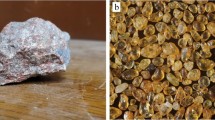Abstract
Highly radioactive waste from defense-related activities at the Savannah River Site in South Carolina are to be incorporated into a borosilicate glass in the Defense Waste Processing Facility (DWPF) for long-tem geological isolation. Processing and repository safety considerations require the determination of 24 radioisotopes that meet the reporting criteria. These isotopes include fission products, activation products, and daughter nuclei that grow into the waste. Four isotopes,137Cs,90Sr,238Pu and238U will be routinely measured in the DWPF operation for process control. This work shows that the concentrations of the other 20 reportable radioisotopes in the final glass product can be predicted from a thorough characterization of the high level waste (HLW) tanks and a knowledge of the concentrations of the major non-radioactive components in the vitrification process.
Similar content being viewed by others
References
G. R. Choppin, P. J. Wong, J. Radioanal. Nucl. Chem., 203 (1996) 575.
Office of Environmental Restoration and Waste Management, Waste Acceptance Product Specifications for Vitrified High-Level Waste Foms, Revision 0, USDOE Document EM-WAPS, U.S. Department of Energy, Gemantown, MD, 1993.
F. W. Walker, J. R. Parrington, F. Feiner, (Eds), Chart of the Nuclides, 14th ed. General Electric Corp., San Jose, CA, 1989.
G. P. Russ, III, J. M. Bazan, Spectrochim. Acta, 42B (1987) 49.
R. M. Brown, S. E. Long, C. J. Pickpord, Total Environm., 70 (1988) 265.
J. S. Crain, D. L. Gallimore, Appl. Spectrosc., 46 (1992) 547.
D. W. Koppenaal, Anal. Chem., 62 (1990) 307R.
D. W. Koppenaal, Anal. Chem., 64 (1992) 325R.
A. C. Almon, W. F. Kinard, R. A. Dewberry, N. E. Bibler, Multimodal Separation of Alkali, Alkaline Earth, Transition, Post-Transition, Lanthanide, and Actinide Cations in Waste Sludge, Symp. on Ion-Chromatography for the Power Industry. New Orleans, LA, May 20, 1991.
W. F. Kinard, N. E. Bibler, C. J. Coleman, S. B. Wyrick, Radiochim. Acta, 66/67 (1994) 259.
W. F. Kinard, N. E. Bibler, C. J. Coleman, W. T. Boyce, S. B. Wyrick, Applications of Inductively Coupled Plasma — Mass Spectrometry to Radiochemical Problems at the Savannah River Site, in: Applications of Inductively Coupled Plasma — Mass Spectrometry to Radionuclide Deteminations, ASTM STP 1291,R. W. Morrow, andJ. S. Crain (Eds), American Society for Testing and Materials, West Conshocken, PA, 1995, p. 48.
Author information
Authors and Affiliations
Rights and permissions
About this article
Cite this article
Kinard, W.F., Bibler, N.E., Coleman, C.J. et al. Radiochemical analyses for the defense waste processing facility startup at the Savannah River Site. J Radioanal Nucl Chem 219, 197–201 (1997). https://doi.org/10.1007/BF02038500
Received:
Issue Date:
DOI: https://doi.org/10.1007/BF02038500




